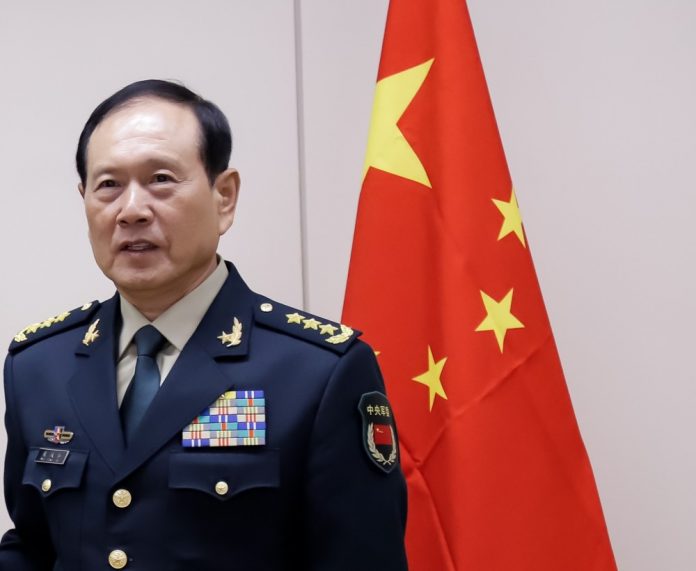In the second week of September this year, Chinese Defense Minister Wei Fenghe visited Southeast Asian countries including Indonesia, Malaysia, Brunei, and the Philippines as tensions in the South China Sea remain.
This high-profile visit from Beijing comes together with Washington’s virtual engagement in the ASEAN Foreign Ministers Meeting, ASEAN Regional Forum, and East Asia Summit this week as tensions heighten in the U.S.-China great power competition in the Indo-Pacific region.
Fenghe conveyed that China is willing to “meet halfway” as things are still “generally stable.” As passive-aggressive as that statement was based on its 2019 National Defense White Paper, Southeast Asian governments have well-received the said minister and discussed possible military-to-military cooperation in areas like humanitarian assistance and disaster response (HADR).
RAND Senior Defense Analyst Derek Grossman argued that the visit can be labeled as “the reset tour” as the abovementioned Southeast Asian states are frustrated with “Beijing’s bad behavior” in the South China Sea and North Natuna Sea.
During Fenghe’s visit to Camp General Emilio Aguinaldo with his Philippine counterpart, Defense Secretary Delfin Lorenzana, he stressed Beijing’s willingness to strengthen their military cooperation with Manila, especially on HADR and the COVID-19 response.
Reports told that Lorenzana invoked the 1982 UN Convention on the Law of the Sea (UNCLOS) and reaffirmed the Philippines’ adherence to the 2016 Arbitral Tribunal award “without any possibility of compromise or change.” However, the Department of National Defense later withdrew the said statement without reason and changed it into a toned-down version.
Fenghe also visited the Philippine President Rodrigo Duterte at the Malacañang Palace and had concluded the visit with a commitment to avoid misunderstanding and peacefully resolve their differences as regards the South China Sea.
As bland as the meeting went, this reflects the Philippines’ tied hand on China’s grip. In the same month, the Philippines has also blindsided the security risks of critical infrastructures, such as Chinese 5G networks in military camps and the Chinese airport development near a Philippine naval base.
The Philippines’ non-confrontational approach with China is ineffective to defend its interests because it crumbled its security alliance with the U.S. in spirit and waged a gap with the electoral preference.
While the Philippines seeks to avoid the two giants like many other ASEAN counterparts, the tragedy of geography leaves the state no other choice but to face them. To survive the international system, states have to maximize their power over the other to survive where it cannot rely on wishful thinking.
If the Philippines wishes to be neutral, it would have to build its military, cyber, and economic capacity to absorb the shock of intense security competition between China and the U.S. Yet, its security alliance with the U.S., and China’s tendency to cheat in a South China Sea cooperation is there.
The Philippines should be concerned about Fenghe’s recent visit because it did not seek peace to accommodate the Philippine interests but only insisted on China’s way to its doorsteps. And it will not stop there. The Philippines’ National Security Policy 2017-2022 states that the reason for China’s aggressive actions in the West Philippine Sea and in the greater South China Sea is driven by “food and energy security demands” and “renewed stirrings of nationalism.”
Within China, concerns mount about its food supply chains due to the COVID-19 pandemic. As China builds its blue-water navy to replace the U.S. as the watcher of maritime traffic, it would have to rely on large energy deposits. Moreover, as China seeks a global example for renewable energy, it intends to use its artificial islands in the South China Sea to power the mainland.
With China’s global controversy of mishandling coronavirus within its borders, it will take great lengths – through carrots and sticks – to avoid persecution. A recent Wuhan victory pool party and the Chinese Communist Party’s celebration over their triumph over coronavirus prove that nationalism will define its way.
Fenghe’s visit does not signal peace, but a mere demonstration of China’s power in domestic and foreign spheres – on what they can do as a rising power in the region. Assuming that it continues to rise after the COVID-19 pandemic, China will pose a conventional armed confrontation to drive the U.S. back into the middle of the Pacific Ocean. In August, Beijing proved that it will not hesitate to use its “aircraft carrier killer” medium-range ballistic missiles in the South China Sea. And the Philippines may not have any leverage to absorb the shock it insists on a false sense of peace.
As the Athenians declared in antiquity, what matters in the world is the preponderance of power of action. The Philippines’ discussions with China should remain open, but it should also remain firm and cautious. While its alliance with Washington is imperfect, it remains as the best leverage for Manila. Yet, it should not be a substitute for upping its military modernization – even in time of a pandemic – to prepare for a conventional war that would redefine the international order once more.
All views and opinions expressed in the article are entirely his own and do not reflect the official position of his office and the AFP.

The author is a Manila-based defense analyst and international affairs academic who works and writes about issues and topics regarding the Great Power Politics of the Indo-Pacific, Philippine Strategic Culture, and ASEAN Studies. He currently pursues his master’s degree in International Studies at the University of the Philippines, Diliman.


